Section 22: Buffer Stops
(Page 1 of 1)
Buffer stops, especially those that coincide with the end of a signalled route, are commonly provided with lights or markers to enhance their visibility. Stopping markers or other miscellaneous signs may also be installed at buffer stops.
Buffer stops at the end of terminal platform lines and certain sidings were provided with lights, which were lit at times of darkness and during fog or falling snow. Normally, a red light was displayed [22.1]; however, a white light [22.2] was used instead where a red light was likely to be misinterpreted by drivers approaching on an adjacent running line.
 |
 |
[22.1] Red Buffer Stop Light.
Area: All Areas
Usage: High
Status: Obsolescent
|
[22.2] White Buffer Stop Light.
Area: All Areas
Usage: High
Status: Obsolescent
|
By 1959, red lights were suspended from the roof of London Euston station (London Midland Region) on the approach side of the buffer stops on Platforms 1 to 3, to indicate their positions.
Experimental electrically lit buffer stop lights were provided on Platforms 1 and 2 at London Victoria station (Southern Region) in August 1965.
Following the introduction of electric buffer stop lights, it became standard practice to provide two lights of the same colour at each buffer stop, usually in a vertical arrangement and placed on the left-hand side [22.3 & 22.4].
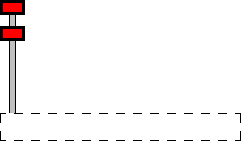 |
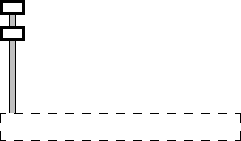 |
[22.3] Red Buffer Stop Lights.

Area: All Areas
Usage: High
Status: Current
|
[22.4] White Buffer Stop Lights.

Area: All Areas
Usage: High
Status: Current
|
On the Scottish Region, the usual arrangement of electric buffer stop lights comprised two lights on the left and one on the right, all three lights being of the same colour [22.5 & 22.6].
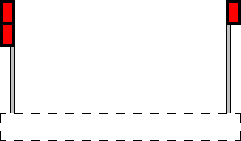 |
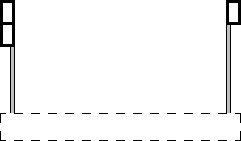 |
[22.5] Red Buffer Stop Lights.

Area: Scottish Region
Usage: High
Status: Obsolescent
|
[22.6] White Buffer Stop Lights.
Area: Scottish Region
Usage: High
Status: Obsolescent
|
|
In 1978 and 1980, the friction type buffer stops at the ends of Platforms 7 to 16 at London Bridge station (Southern Region) were each provided with a circular red target [22.7].
|
 |
[22.7] Buffer Stop Target.

Area: London Bridge
Usage: Medium
Status: Historical
|
|
|
In May 1984, the buffer stop at Neilston (Scottish Region) was experimentally fitted with two reflectorised red and white diagonally striped plates [22.8] instead of lights.
|
 |
[22.8] Buffer Stop Markers.
Area: Neilston
Usage: Low
Status: Historical
|
|
|
In May 1991, a white T-shaped board was erected between the rails, in line with the top of the ramp of the Stourbridge Town branch platform at Stourbridge Junction station (London Midland Region). Two red lights were attached to the cross member [22.9].
|
 |
[22.9] Red Buffer Stop Lights.
Area: Stourbridge Junction
Usage: Low
Status: Historical
|
|
|
In June 1991, a marker post comprising a yellow disc mounted on a yellow and black striped pole [22.10] was provided at London King's Cross, between Platforms 7 and 8. The post acts as a stopping marker for High Speed Trains and trains composed of Mark 4 coaches, to ensure that stock is positioned correctly for watering purposes. Similar marker posts have also been installed at Platforms 1 to 6.
|
 |
[22.10] Marker Post.
Area: London King's Cross
Usage: Low
Status: Current
|
|
|
By 1996, a standard form of reflectorised board was introduced, for mounting on buffer stops at the end of signalled routes. Coloured red with a white horizontal bar [22.11], this board is usually fitted in addition to any buffer stop lights.
|
 |
[22.11] Buffer Stop Board.

Area: All Areas
Usage: High
Status: Current
|
|
|
Kyle of Lochalsh was the site of a further trial involving the provision of reflectorised targets at buffer stops. In January 1999, two circular red targets were fitted one above the other on a post mounted at the left-hand side of each buffer stop [22.12].
|
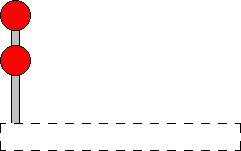 |
[22.12] Buffer Stop Targets.

Area: Kyle of Lochalsh
Usage: Low
Status: Obsolescent
|
|
|
At London St. Pancras in August 2002, a circular white marker on a sprung post [22.13] was installed in the 'four-foot' of each platform line, two metres in front of the buffer stop. They were removed shortly afterwards.
|
 |
[22.13] Marker Post.
Area: London St. Pancras
Usage: Low
Status: Historical
|
|
|
In December 2002, marker poles painted with yellow and black bands [22.14] were provided on the approach to the buffer stops on Platforms 2 to 7 at Glasgow Queen Street High Level station. Each pole is situated in the space between two lines and acts as a stopping marker for multiple unit trains. Similar marker poles have also been installed at Helensburgh Central and Larkhall stations.
|
 |
[22.14] Marker Post.

Area: Predominantly Scotland Zone
Usage: Low
Status: Current
|
|
|
In June 2012, the three red lights (see [22.5]) on the buffer stops on Platforms 7 and 8 at Stirling station were replaced with reflectorised markers as a trial. Each marker has a red diagonal cross on a white background and is surrounded by a red border [22.15]. The same style of reflectorised markers were fitted to each of the buffer stops at Glasgow Queen Street High Level station in 2016.
|
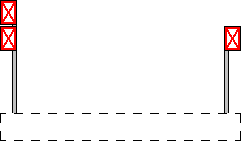 |
[22.15] Buffer Stop Markers.

Area: Scotland Route
Usage: Low
Status: On Trial
|
|
Door release reminder signs have been placed on or adjacent to the buffer stops at the end of some terminal platform lines. These show the relevant platform number and indicate which side of the train to release the doors on. The signs provided from 2019 at some stations where London North Eastern Railway services terminate display the relevant platform number on the upper part, whilst the lower part contains a letter "L" or "R" with an arrow to the right of it [22.16]. The equivalent signs on the Anglia Route have the platform number and arrow at the top, with text underneath [22.17].
 |
 |
[22.16] Door Release Reminder Sign (e.g. platform on left-hand side).
Area: London North Eastern Railway
Usage: Medium
Status: Uncertain
|
[22.17] Door Release Reminder Sign (e.g. platform on right-hand side).
Area: Anglia Route
Usage: Medium
Status: Uncertain
|
|
Signs have been installed on the buffer stops of Platforms 4 to 6 at London Charing Cross station (Kent Route) to remind drivers of Class 465 'Networker' electric multiple units that the platform can accommodate ten cars. Each sign shows an exclamation mark and the wording "Class 465 10 car platform" on a white triangle with a blue border, against a grey background [22.18].
|
 |
[22.18] Platform Length Reminder Sign.
Area: London Charing Cross
Usage: Low
Status: Current
|
|










